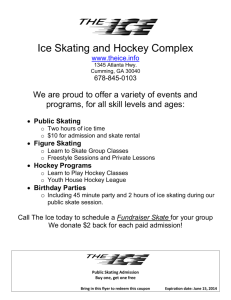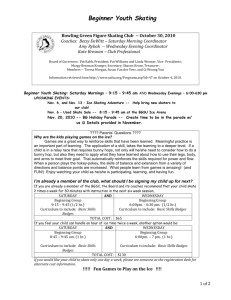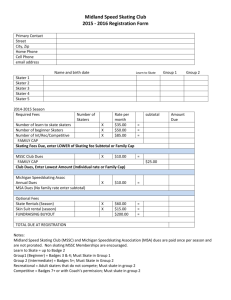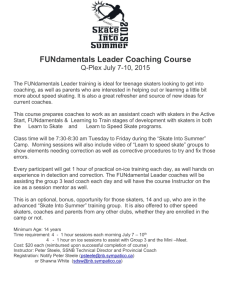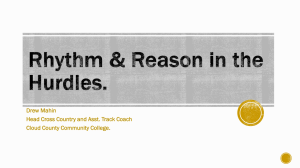Speed Skating Skills Book Updated August 2012
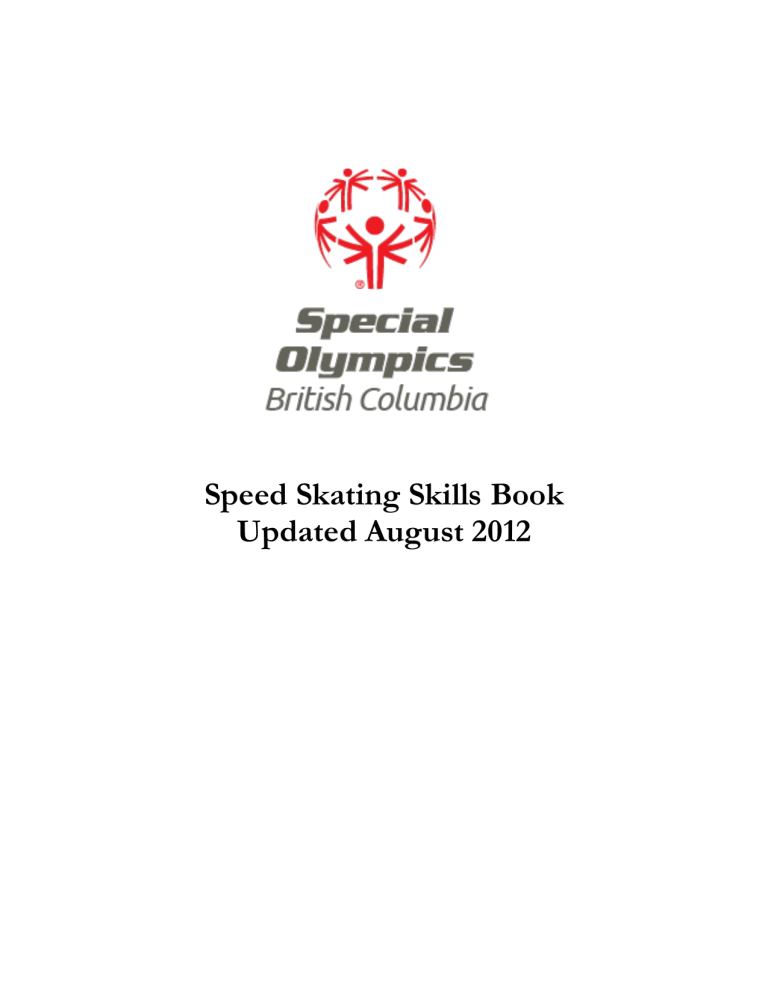
Speed Skating Skills Book
Updated August 2012
Coaching Principles
STEPS IN TEACHING A DRILL
1.
Introduce
2.
Demonstrate
3.
Explain
4.
Organize
5.
Execute
6.
Correct
7.
Practice
GENERAL PRINCIPLES
Drills should relate specifically to what you are teaching.
Athletes should be made aware of how drills relate to the sport.
Drills should only be a part of your practice.
Drills should be introduced at a slow pace and then gradually increased
Drills should be accommodated for fitness, age and abilities.
Drills should move from simple to complex. First perform drills that will help keep the interest of athletes.
Drills should relate to the system of play that the athletes will use.
Perform a variety of drills to prevent monotony.
As fatigue sets in, technique deteriorates so provide frequent rest periods.
EXECUTION PRINCIPLES
Review the drill procedure before practice so you know how it works.
When introducing a new drill, walk a group of athletes through it so others can see how it is performed.
Avoid talking too much, get the athletes performing, they will learn by doing.
When errors occur, the drill should be stopped momentarily to correct errors.
Praise those athletes doing the drill well and encourage those having difficulty.
If equipment is necessary, ensure it is set up before so that progression from one drill to the next can progress smoothly.
1
Warm Up
The warm up should be used as a time for the athletes to get used to their skates, the ice and the environment. The warm up should be done at an individual pace with the emphasis placed on proper technique. By the end of the warm up, the skaters should be mentally and physically ready to learn a new skill or to push the body harder in a conditioning drill.
Basic Body Position on Ice- Ten Commandments
1.
Keep feet shoulder width apart, providing a stable base of support.
2.
Maintain ankles in a neutral position so that you are directly over the top of the blade.
3.
Position both skates parallel, pointing straight ahead in the direction of travel.
4.
Flex knees about 100 degrees, placing the thighs almost parallel to the ice.
5.
Center the body weight over the middle to back 1/3
of the skate
6.
Flex the trunk forward from an upright position about
60 degrees with a slight rounding of the back.
7.
Rest both arms comfortably on the middle of the
lower back.
8.
Hold shoulders level ( as viewed either from behind or in front) and pointed straight ahead ( no rotation of the spine and upper body)
9.
Hold head upright, with eyes looking ahead.
10.
Keep the body as relaxed as possible.
2
Speed Skating Motor Skills
Speed skating can be broken down into six major components: balance/standing, gliding, pushing, stopping, turning and skating backwards. Each skater will progress through these skills at their own rate, however, early emphasis should be placed on balance/standing and gliding.
Balance:
Stand on two feet ( holding board if necessary)
Feet together, legs and ankles straight
Knees bent, ankles straight
Balance on one foot
Rock forwards and backwards.
Walking:
Penguin walk- skate in V position, walk on skates
Walk on ice with eyes closed. Stop, turn around and return to starting point.
Shuffle walk across ice.
Walk in a zigzag formation
Forward Split Stand
(Lunging forward)
Legs straight
Knees bent
Switching back and forth
Falling/ Getting Up:
Kneeling on ice, arms out, fall forward and cushion with arms
Place hands under body, bring one knee up and then the other.
Jumping:
Jump while standing still
Jump while turning
Once comfortable, jump up while turning.
Perform it on one foot
3
Technique for Speed Skating
Technique
Basic Position:
Ankles straight, not caving or leaning in
Skates shoulder width apart
Blades parallel and point straight ahead
Knees over toes
Legs bent about 90 degrees
Elbows on knees with hands clasped
Back bent at least 45 degrees in a relaxed position
Center of gravity in middle of the blade
Head and eyes looking straight ahead about 10 inches in front.
Drills for basic position:
Take a few steps and then glide down ice in basic position. Check for parallel skates and straight ankles.
Have skaters rock back and forth in the basic position to practice changing the center of gravity.
Arms:
Swing back and forth
No higher than shoulders front or back
Relaxed but still in a controlled manner
Hands are relaxed
Slight bend in elbows in front.
Drills for arms:
Have skaters swing arms like a pendulum but no higher that the shoulders in back or front.
Hands should be open. Clenched fists are not beneficial.
Take a few strides, assume basic position and swing arms. Look for relaxation and rhythm.
4
Technique for Speed Skating
Return of the leg:
Holding onto the boards, practice bringing the leg back into the body after a push.
Push to the side, relax the leg and allow it to swing behind you.
Knee should be bent and leg in a parallel plane to the supporting leg
Return leg to starting position
Knees and feet should be close together
Drills for leg return:
Have skaters take a few steps, assume basic position and then practice recovering with one leg and then the other.
Go from on end of the rink to the other pushing and recovering with right leg.
Next length, do the left leg. Look for push with whole skate and entire leg.
Now, add arm swing!
Turns:
The turn can be broken down into four main components: basic position, push side to side, arms and crossing over. This is the hardest skill for skaters to master so patience and practice will be needed. It is sometimes easiest to work through each component of the turn and then put it all together.
Points to remember with the turns:
Same as the basic straightaway except that the entire body should be
lean in towards the centre of the turn.
The pushing should be out to the sides, not to the back..
During the crossing over, feet should be kept as close to the ice as possible.
Place the skate in the direction of travel so that feet will not have to be moved once they are on the ice.
5
Technique for Speed Skating
Starts:
The start has two components to it; the starting position and the actual movements of the start. In order for skaters to have a powerful beginning to their race, they need to be able to exude the necessary force with their skates.
This will come from both the starting position and the first 3 steps.
When starting:
Skates should be parallel and about 45 degrees from the starting line.
Feet are shoulder width apart, a strong base ready to spring from.
Knees must be bent to provide the spring and power.
Leading arm is comfortably in front and the elbow bent ready to swing.
Trailing arm is slightly bent and ready to swing forward.
Weight should be evenly distributed.
First Three Steps (right legged start)
Right leg takes a very short step just over the starting line.
At the same time, right arm pulls back and the body straightens out.
The left arm swings forward as if you were going to punch someone.
Left leg pushes.
Second step is just the opposite.
Left foot comes forward.
Arms continue the punching forward and back.
The third step is the complete opposite of the second step.
6
Speed Skating Skills
Stopping:
Being Pushed:
Athletes push each other in these 4 ways
Standing straight feet together
Knees bent, feet together
Standing feet shoulder width apart
Knees bent, feet shoulder width apart
Standing on one foot
Stopping: (3 Ways)
1 foot snowplow: Push one foot out sideways to stop
2 foot snowplow: Push both feet out so that tips come together
2 foot snowplow: Turn both feet sideways to the direction that you are travelling- like a hockey stop.
Practice skating to and stopping at different lines across the rink.
Pushing:
The T position is the pushing motion used for speed skating.
The back skate is 90 degrees to the front skate. Weight should be on the forward leg.
T-Push I:
Face boards and hold onto side
Knees bent, back foot is in T position ( 90 degrees to front skate)
Push skate back to make pile of snow
Repeat several times, then switch to opposite leg
T- Push II:
Face boards and place left skate behind the right skate in the T position.
Bend knees and push off while maintaining a flat blade to the ice.
7
Speed Skating Drills
Drills:
Line Jumps:
Athletes line up across the end of the ice.
Skate to the first blue line, stop and perform a two-foot jump over the line.
Continue to skate to and jump the center line
Continue to the next blue line and jump
Shuttle Skate:
Distribute objects across one blue line.
Players start at one end of the ice, skate to the blue line, pick up a ring with one hand.
Skate to the next blue line and gently drop the ring on the second blue line.
Chair Drill
Have athletes push chairs around the ice.
Divide athletes into two teams and create a relay.
Starts:
The position and starting steps that make up the start can easily be done off the ice as you can position the feet for starting and practice the follow up step more easily.
Determine if the athlete is more comfortable with the T start (feet in letter
T or the parallel start (both feet 45 degrees to the start line).
Then have athlete stand in the start position, check to see feet and entire
body are in position.
When body is completely still, blow the whistle.
Athlete should start by making 6 short choppy steps in V formation, then
glide into the corner.
Starts on the ice:
Move to starting line. This is approx. 5 feet from race line.
Best to have only 2 athletes at one time.
Move into starting position.
Start the next athletes on a ½ lap race and then the next group starts.
Expand from ½ lap to full lap, combine with cross over.
8
Speed Skating Drills
Passing:
The inside and outside pass can be easily introduced off ice and practiced even at home. This technique is used by athletes to help them skate around other skaters.
Put an obstacle (large cone) in the walking path of an athlete, and a bucket on the obstacles’ left side in a ways.
Athlete should walk up to the cone quickly and move toward the bucket out and around the cone and back in line or on track.
This is inside pass, and will be more beneficial to the athlete because it is a shorter distance than the outside pass.
On Ice:
Skater comes up from behind to the obstacle and skate to the inside, out, around and in.
Substitute another skater for the cone. This can be done by staggering starts. In staggered starts, a slower skater starts a bit ahead of the faster skater, the faster skater approaches and passes. Repeat this so all skater have the opportunity of passing.
Adding more skaters up to 5 each ahead of the other can enhance this.
Crossovers:
This is one of the hardest skills to teach the athletes.
Off Ice:
Step side to side, then add speed and go in either position
If inside, stand 90 degrees to a staircase and do crossovers up the stairs
If outside, stand 90 degrees to a hillside and do crossovers up the hill
Crossovers On Ice:
Skate the circles that are painted on the ice (usually 5)
Have left leg on the circle and right leg extended as you go around the circle moving the right leg over into crossover.
Skate one circle, then over to next circle, and so on.
Standing on the centerline of the ice, walk crossovers in one direction and then the other.
9
Speed Skating Drills
Corner crossovers:
Goal is for 5 crossovers in a corner – 2 going in, 1 in the apex and 2 going out.
Crossovers involve skaters trusting their blades- a good drill for this is going in and out of a line of cones.
10
Fitness Component
Having a good fitness level in speed skating is very important as the sport requires you to exert an explosive force of power.
Jogging is always a good way to elevate the heart rate but also adding in some leg work such as jumps will challenge the athlete even more.
Be sure to incorporate a fitness component at every practice.
This can be skating laps around the rink at increasing speeds, or in intervals. Have skaters skate quickly up the straights and slowly around the corners.
Tuck Jumps:
Bring the knees up to your chest.
As soon as the feet touch the ground again.
Split Jumps:
Put your right leg forward put your left knee on the ground behind you.
Now, jump up, and switch legs.
When the back knee touches the ground, jump again.
Keep jumping continuously without rest for a set of 10.
Crossovers:
Position yourself into skating position.
Put left leg behind the right one.
Jump from the right leg to the left leg and finish by putting your right leg behind the left one.
Keep the head up, look straight ahead.
Keep hips straight and don’t twist.
Repeat for 30 seconds.
Step Ups:
Find a step/box/bench.
Stand perpendicular to the step.
Come up onto the step with the right foot and then down. Repeat 10 times
Alternate legs for 10 reps.
11
Practice Plan
Unstructured Free Play (10 min)
Prior to the practice athletes who have arrived early should be encouraged to participate in free play activities.
Warm Up (10-12 min)
Warm up should start with a light jog to get the athletes’ heart pumping. Athletes should then gather to stretch, starting slowly and gradually involving all the muscles and body parts to be utilized in the exercise related instruction phase of the practice.
Basic Motor Skills (15-20 min)
Basic Motor Skills are defined as the very simplest movement skills (i.e. running, kicking, jumping, throwing, catching, etc). This phase starts with known content and progresses to the application of skill(s) resembling the game/competition, allowing athletes to fine-tune these basic skills to enhance the acquisition of sport skills. It should focus on one specific skill at a time. The combination of 2 or more skills will be encompassed in the next section.
Sport Specific Skills (15-20 min)
During this phase the athletes will combine several basic motor skills and practice the skills as demonstrated during the instruction. Emphasis should be placed on creating competition-like conditions (through game-like drills) during this phase.
Fitness (12-20 min)
This phase involved physical conditioning activities that are specific to the fitness needs of your sport. This is done by setting continual work/pause ratios (through circuits) for your athletes that stress the correct energy system(s). Fitness encompasses cardio, muscular strength, muscular endurance and flexibility.
Simulated Game (10-15 min; for team sports only)
During this phase athletes will compete in a competition-like setting to incorporate all the skills they have learned as well as the rules of the sport. Infractions should be called so that the athletes learn all aspects of the sport.
Cool Down (5-8 min)
Don’t forget this portion. Cool downs are a vital part of a practice as they allow the heart rate to return to normal. Stretching should also be included at this time to prevent sore muscles the next day.
Evaluation/Tips (5-10 min)
Evaluation is used to assess the effectiveness of specific activities or the total practice. It is helpful to spend a few minutes with your athletes at the end of a practice to get some feedback on the practice session. It can take the form of a 5 minute wrap session about things that went well and things that the athletes and/or coaches need to work on. The topics discussed can be built into the next week’s practice. All around training should also encompass nutrition and/or mental training so it is important to discuss these items with your athletes as well.
**NOTE: for additional resources, go to www.specialolympics.bc.ca
and click on Resources**
12
